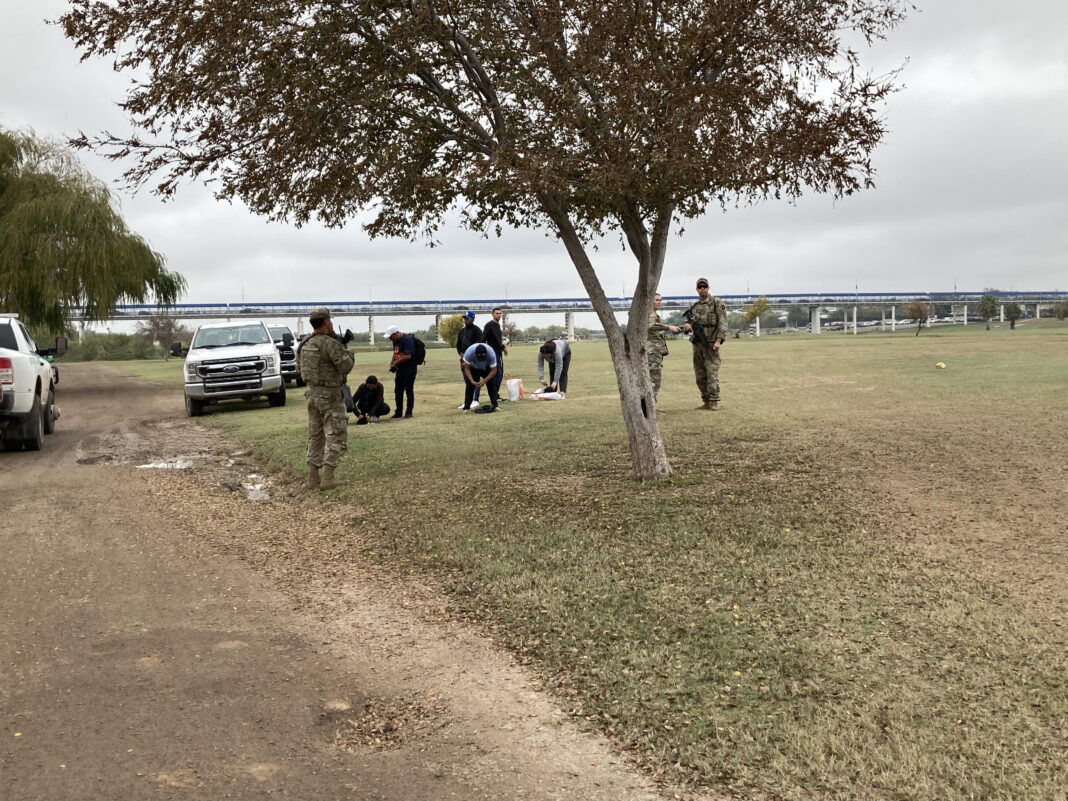On this December 18, International Migrants Day we recommit our efforts to amplify the voices of those seeking refuge and asylum at our borders and redouble our support to those human rights defenders at the U.S.-Mexico border. From the editors
Over the weekend (December 9,10) the El Paso Sector experienced a major surge in illegal crossings, with a 3-day average of 2,460 daily encounters, primarily through the downtown area of El Paso. CNN
Three of us from the Journey for Justice Caravan organized by Witness at the Border arrived in El Paso in the early evening of December 9. We parked close to the U.S.-Mexico border in the downtown area. We proceeded to the Agricultural Workers Project two blocks away. To get there we had to cross about three lanes, bumper-to-bumper cars streaming south of the border into Ciudad Juarez. Being a Friday all those who worked in El Paso were going home. At the same time a stream of migrants, miles long, was coming north which we did not see then. We saw it in the news later.
At the Agricultural Workers Project, there’s a shelter on the first floor. The person in charge once she checked with the right persons let us in to talk to the families in the shelter, both migrants and houseless. Before we did, she made it perfectly clear that we were not to take anyone’s photo. This was to protect their identities since some migrant families were fleeing danger, and if their identity was known, their families back home might get killed.
She took us around informing us that the shelter takes about 80 families at a time; they stay here until they get shelter at another location and/or receive money from their families to go to their end destinations. The shelter it’s an empty space, with no furniture, only blankets spread out on the floor, which delineates a family’s space, which no one can cross. For larger families, there are rooms on the other side of the hallway with two bunk beds on each side of the walls.
We first talked to German (not his real name to protect his identity).
“I’m Venezuelan. I came with my wife and three children, two boys and a girl. The journey took about a month and a half. We crossed through the forest (Darién Gap). It was very difficult, especially for my children, but we finally got to the U.S.-Mexico border and asked for asylum.”
Why did you come, is it the economy, politics, or violence? “Everything” he responded and his voice cracked with emotion as he said “todo.” As we talked, a young girl, who seemed to be seven came and hugged German, while two boys nine and eleven ran past us. “My children,” German said with pride.
“Now I have to work, work, work. I’ve been working picking chiles and fixing tires in a tire shop. I have to make money because I have three families to support, my own, my mother’s, and my mother-in-law’s.”
German is in his 40s and is an attorney back home.
Next, we interviewed a family from Nicaragua.
María (not her real name), a mother with a 10-year-old son, and Sonia (not her real name), her 20-year-old daughter, with her three-year-old daughter.
This family was not as talkative as German. They came to the shelter the day before, while German’s family had been there for a few weeks and his children were already going to school.
There was sadness on this family’s faces, although they smiled, they also seemed apprehensive, especially María. When asked why they had left their home country, the mother spoke of the situation in Nicaragua, the violence but without details, and the economy.
Their trip had been quicker than German’s had been. It only took two weeks and it seemed less arduous; they traveled by bus to the border. According to them, they had no problem getting processed and entering the United States. While they didn’t say anything, it’s clear that their reasons for leaving Nicaragua were pretty sound for them to be processed so rapidly and without avail.
When we asked them if they go outside the shelter during the day, both mother and daughter looked at each other and shook their heads. When we prodded for answers, they just said, “We’re safe here.” God knows what they’ve been through.
Other members of the Caravan for Justice went to the Greyhound station. I spoke to one of them and he told me the Greyhound station was full of migrants walking around with sheets of paper in their hands, backpacks on their backs, and shoes without shoelaces. He told us he was going back in the morning with others to take more supplies to the migrants there.
I spoke with another member of our group and asked why they took the shoelaces away. She told me that when she was in Del Rio a couple of days earlier, she saw a group of migrants surrendering to the border patrol officers and the first thing she saw was the border patrol agents ordering migrants to take off their shoelaces and hand them over.
These are the so-called invaders, whose only dangerous weapon seems to be their shoelaces, against which [Texas] Governor [Greg] Abbott sent the National Guard, gunboats, and Texas Department of Public Safety (DPS) officers. And he called for an allocation of about $4 billion to pay for its display of force?
Wouldn’t this money be better spent welcoming these migrants, feeding and sheltering the homeless in our cities?
What Invasion? What Arms? Shoelaces?

Sometimes it’s worth going to the source, the dictionary to define what we’re talking about. I’m referring to the use of the word invasion by Governor Abbott of Texas. He called the influx of migrants an invasion. https://gov.texas.gov/uploads/files/press/County_Judge_Invasion_Letter.pdf
By Abbott calling it an invasion, he invokes the Invasion Clauses of the U.S. and Texas Constitutions to fully authorize the unprecedented actions Texas is taking, including devoting more than $4 billion toward border security and enhanced public safety measures.
The dictionary defines the word invasion as, “an instance of invading a country or region with an armed force … an unwelcome intrusion into another’s domain.”
In the case of migrants at the U.S.-Mexico border, we see that neither definitions fit the situation. Migrants are not carrying weapons or arms. The thousands of migrants fleeing government and cartel violence, and the devastation of their economies are not armed. They come only with their clothes on their backs and babies in their arms begging for safety and refuge for themselves and their families.
In addition, these migrants are not unwelcome. Americans continue to support protection for migrants, “by 53% to 23% Americans say the U.S. should continue to offer asylum to people who arrive at the border, if they are found to be fleeing persecution, according to a new survey conducted for the Times by the YouGov polling organization.” L.A; Times
El Tribuno del Pueblo brings you articles written by individuals or organizations, along with our reporting. Bylined articles reflect the views of the authors. Unsigned articles reflect the views of the editorial board. Please credit the source when sharing: tribunodelpueblo.org. We’re all volunteers, no paid staff. Please donate at http://tribunodelpueblo.org to keep bringing you the voices of the movement because no human being is illegal.




Thanks for writing about the truth about why these families need our support.